Negoska Tales: The Rise of a Rare Grape
This storied rarity, grown nearly exclusively...
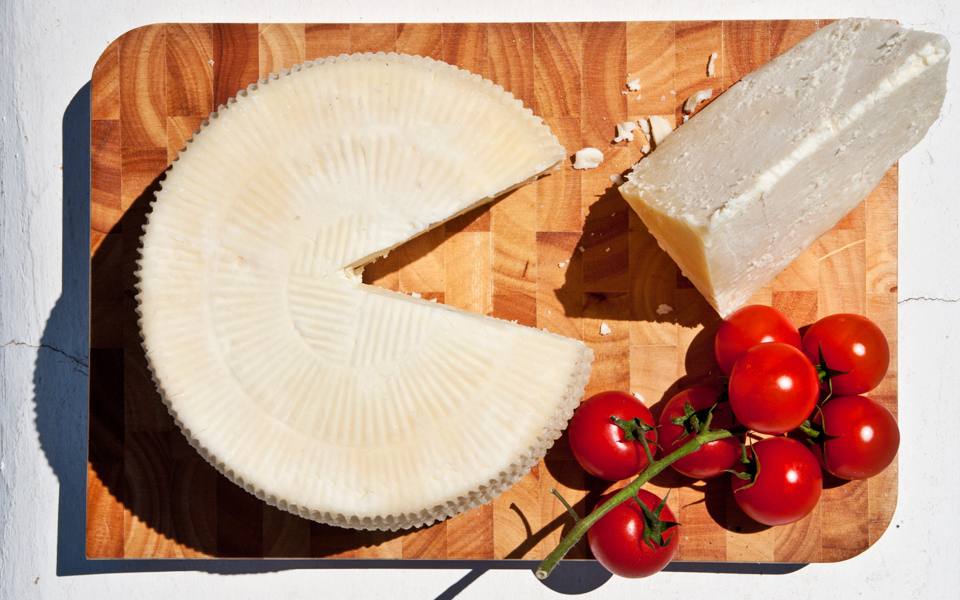
Mykonos is home to some delicious products which encapsulate the island's deep gastronomic traditions
© Evelyn Foskolou
The island has excellent cheeses to offer, either made by traditional small-scale producers – farmers who keep livestock on the island and also make their own cheese – or by commercial cheese-making establishments. Tyrovolia is a white, soft cheese that is used as the basis for traditional Mykonos savory or sweet pies. It can be eaten raw in salads, added to sauces or used in combination with a variety of ingredients as, for instance, in a filling for zucchini or squid. Xinotyro is a white, slightly soured cheese (traditionally shaped in small baskets made of bulrushes), similar to xinomyzithra whey cheese. It is eaten fresh in salads or, when matured, grated over pasta to accompany a tomato or ground-beef sauce. The indisputable queen of local cheese-making, however, is kopanisti (Cyclades PDO), a spicy cheese matured for at least two months, during which an orgy of fungus growth (led by the Penicillium roqueforti responsible for the European Roquefort-type cheeses) takes place. The result is a cheese that resembles the environment in which it was born; intensely spicy, peppery and creamy, with a distinct aroma. Kopanisti is usually combined with tomatoes, grapes, figs or watermelon, and is also a great accompaniment for ouzo.
“The indisputable queen of local cheese-making, however, is kopanisti (Cyclades PDO), a spicy cheese matured for at least two months.”
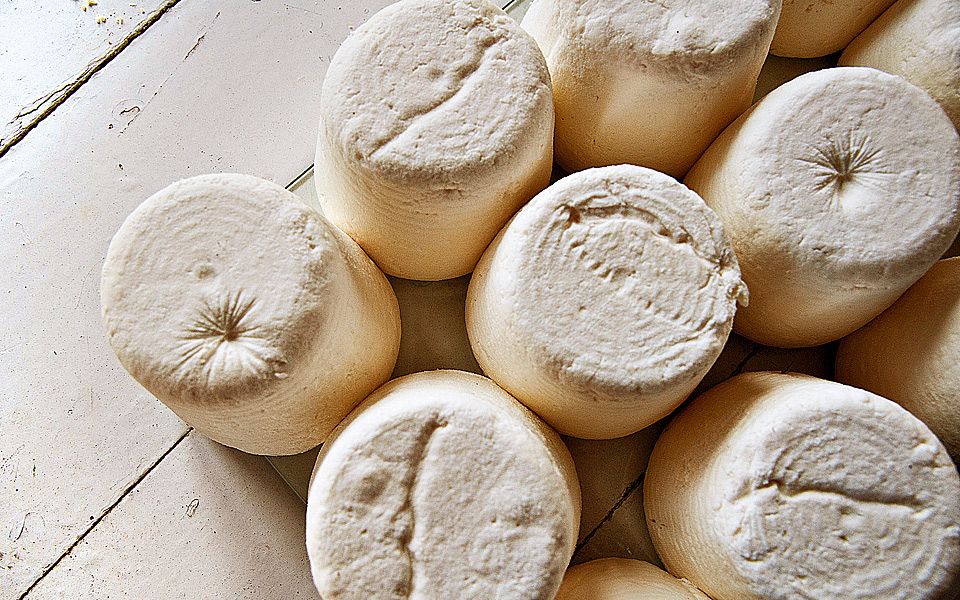
Xinotyro strained in a woven basket and eaten fresh at the table.
At cafés and restaurants, one often comes across it served on a rusk with tomato and oregano as a special Mykonos appetizer known as “mostra”. More recently, a certified facility, the “Mykonos Creamery” (run by the Koukas family in the Paliokastro district of Ano Mera) has begun commercial production. They own 120 milk cows and produce the other two traditional cheeses – tyrovolia and xinotyro – as well. They have developed a strained yogurt, immediately popular with local and non-local consumers alike, thanks to the traditional methods used to make it.
Another modern cheese producer opening soon in the Aghios Lazaros area of the island under the name of “Mykonos Farmers” will be run by Giorgos Syrianos and Thanassis Kousathanas. Both sons of farmers, their goal is to create delicious cheese using traditional local methods based mainly on sheep’s and goat’s milk.
“Another modern cheese producer opening soon in the Aghios Lazaros area of the island under the name of “Mykonos Farmers” will be run by Giorgos Syrianos and Thanassis Kousathanas. ”
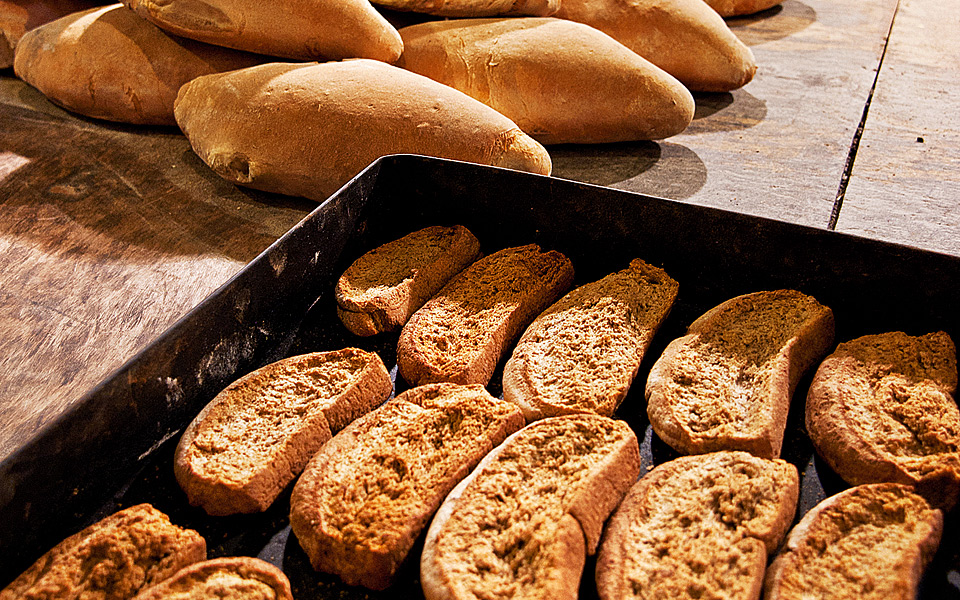
The famous Mykonos barley rusks.
© Evelyn Foskolou
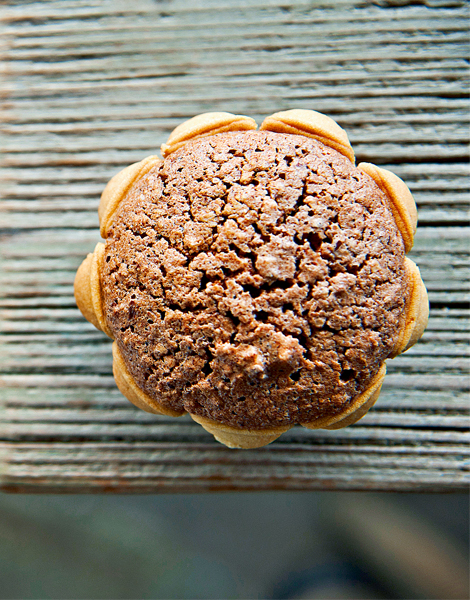
Kalathakia (little baskets) are the preferred treat of locals
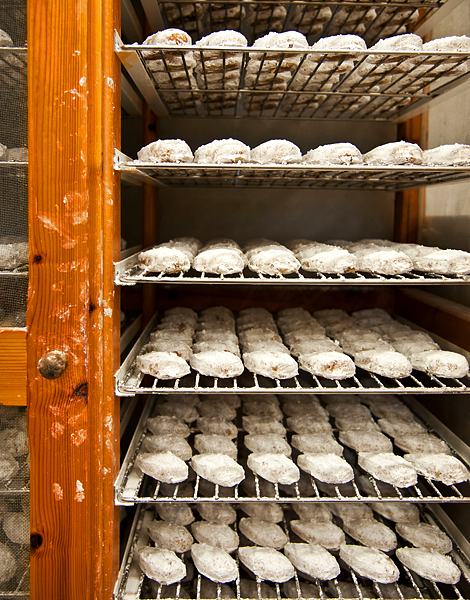
Mykonos almond cookies are a famed sweet.
© Evelyn Foskolou
The windmills, like sleepless sentinels protecting the town, have withstood the ravages of time and now stand as reminders of the pre-industrial era of the island when they supplied the bakeries with flour milled from local barley and imported wheat. Greek and foreign freighters, together with the Russian fleet, were the main customers for bread and twice-baked hardened bread, the famous Mykonos rusks that could endure long sea journeys. To make them, the bakers never used hard-to-come-by firewood for the ovens, working instead with dry brushwood brought down from the surrounding hills by caravans of donkeys right up until the 1960s. These special, time-resistant Mykonos rusks are now made by all of the bakeries in Mykonos.
One particular bakery, a true monument to the history of bread-making, still operates in Chora. “Gioras,” the Vamvakouris family bakery, uses a traditional wood-burning oven and continues to make excellent bread with starter dough, rusks and other items, just as they have been made for centuries. It is near the windmill district and well worth a visit. (Tel. +30 22890.277.84)
As for traditional Mykonos sweets, these include amygdalota almond sweets, cookies and kalathakia, small tarts with an almond-based filling. These are served at baptisms and name-day celebrations and are found at nearly all the island’s various patisseries, including “Kyklamino” on the Peripheral Road in Kamalafka, and the old shop formerly run by the Skaropoulos family and now operating as “Matsouka” in Chora, at the beginning of the road to Ano Mera. The latter also stocks locally made loukoumia (Turkish delight) in various flavors.
“As for traditional Mykonos sweets, these include amygdalota almond sweets, cookies and kalathakia, small tarts with an almond-based filling. ”
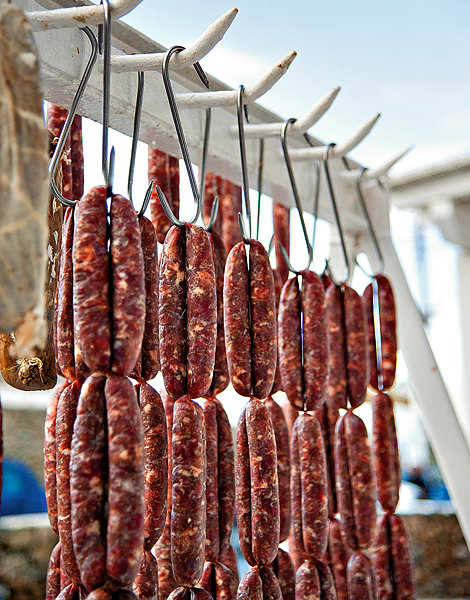
Mykonos country sausage with the scent of summer savory.
© Evelyn Foskolou
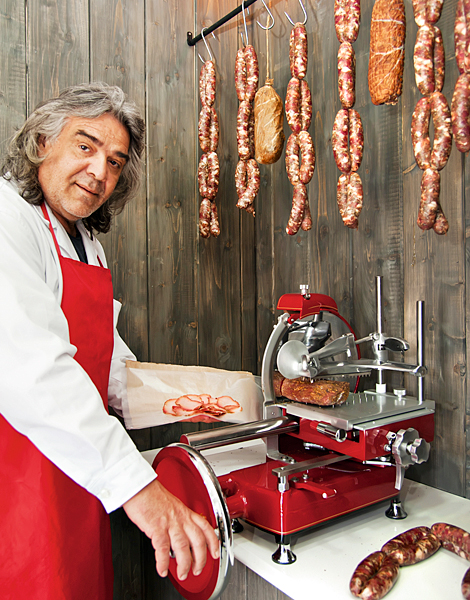
At Stavros Menagias’ butcher shop, you will find excellent, freshly cut louza and other traditional products.
© Evelyn Foskolou
The Mykonos Pig Feast is part of a living tradition that connects the present with the distant past. It represents the island’s Dionysiac side, which is still strong. Long before the feast takes place, a pig is killed. Twenty years ago, this would have provided farming families with meat for a year and formed the basis for many traditional local dishes. The pork from the pig was served with wild greens and winter or summer vegetables, in pies and in many other forms. It also would have furnished the items for a special feast, which remains an important event for Mykonians. The Pig Feast takes place at the tail-end of a large get-together, either with the family or with neighbors. The items consumed during the pig feast include: louza, the exquisite cured meat of the island, made from the pork tenderloin matured in the northerly wind and seasoned with summer savory, oregano, allspice, salt and pepper; the “dry sausages,” seasoned with locally available summer savory and oregano; lardi (cured pieces of subcutaneous fat); bouboulo (tenderloin prepared like louza), paides (ribs using the same herbs and spices), and sisera (pork rinds) fried in large pots and stored in their own fat.
Traditionally, some of the more typical Mykonian dishes based on a “nose-to-tail” eating philosophy – which has become a global trend garnering substantial press – are served at these feasts. These dishes include: pig feast meatballs with hand-cut ground meat, summer savory and oregano; fried pig’s liver; lung and sweetbread stew; provasia (local greens) with lard; and a boiled pig’s head with collard greens. In recent years, many of these delicacies can be found at the butchers on the island and some can also be sampled at restaurants.
For more, read “Tastes of Sacrifice: The Pig Feast on Mykonos” (D. Rousounelos, Indiktos Publications, 2002)
“Traditionally, some of the more typical Mykonian dishes based on a “nose-to-tail” eating philosophy – which has become a global trend garnering substantial press.”
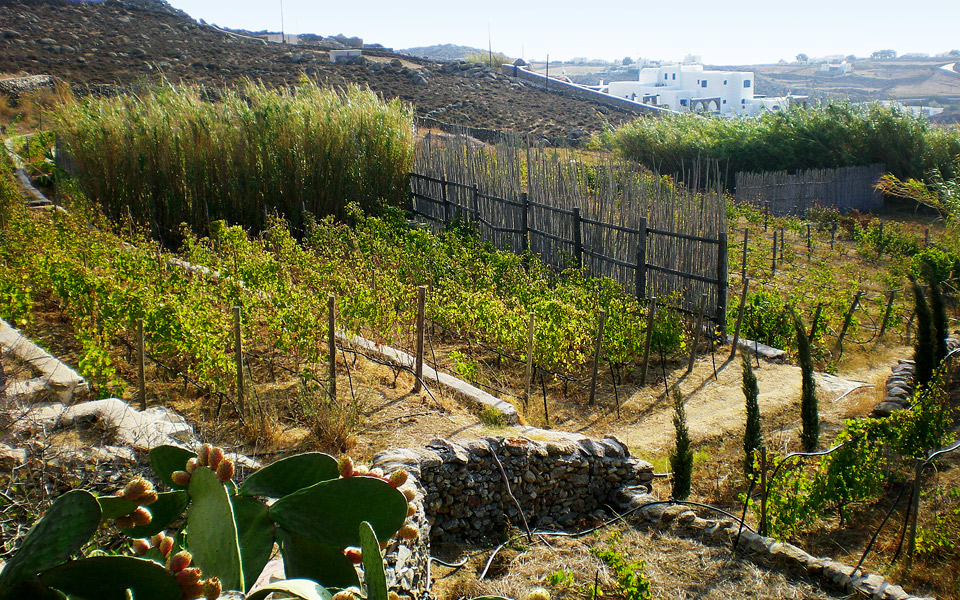
Local wines are produced from native varieties, including Kountoura, Xeromaherouda and Kouforogo
© Evelyn Foskolou
Today, small vineyards and traditional grape presses can be found scattered around the island, while historical references obtained from travelers’ notes and merchant ledgers testify to the existence of viticulture in the past. The wine produced in Mykonos is mainly a sun-dried, deep red varietal known as Mavri Kountoura (Mandilaria) that thrives on the island and is known for its particularly intense color. Other varieties cultivated here include Xylomachairou (white and red), the white Pariano (Monemvasia), Potamisi (white and red), the black-grape Askatharia, the white Kouforogo and the red Agianiotiko.
The island does not have an established winery per se; the wines from the Vioma estate (Paraportiano) owned by Nikos Asimomytis are made off-island, but sold in many locations in Mykonos. Local dentist Giorgos Xydakis also produces some interesting wines from the locally grown grapes. He is a member of ER.O.S. (www.erosmykonos.gr) and his wines can be found at the Sale e Pepe Restaurant (where Cycladic wine tastings take place daily); at Captain’s on the Mykonos waterfront; and at Menagias Butcher Shop on the Peripheral Road, among other locations.
“The wine produced in Mykonos is mainly a sun-dried, deep red varietal known as Mavri Kountoura (Mandilaria) that thrives on the island and is known for its particularly intense color.”
This storied rarity, grown nearly exclusively...
One of the most impressive canyons...
Explore the story and flavor of...
Athens sizzles with culinary creativity, blending...